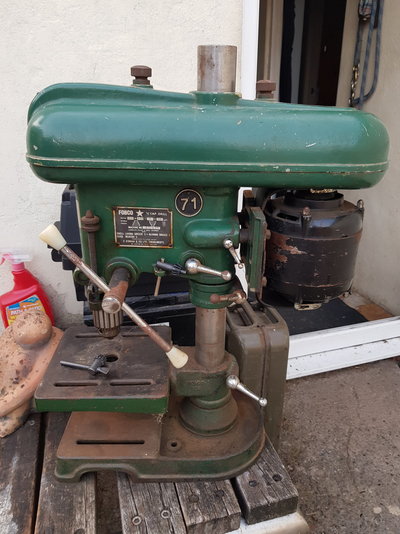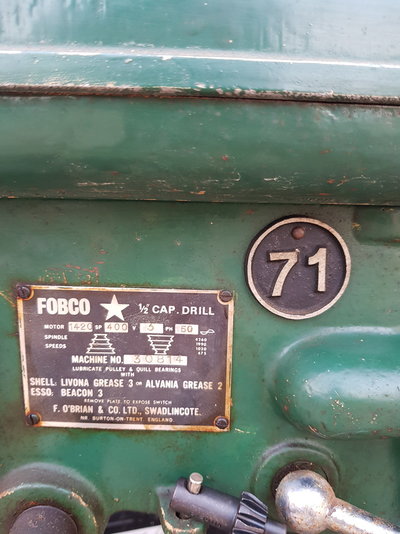hotponyshoes
Member
- Messages
- 6,931
- Location
- Somerset. Uk
Just posting this here so I have some sort of reference in a years time when I find all the bits for this in a box but I will probably have some questions as well!
I was looking for a half decent bench mounted pillar drill for home use.
This is only for my own little projects, mostly one-offs.
Local stockists had the generic Sealey/Draper types in stock but for just under the same price as a new one of those I picked up this pretty old lump of English iron.

I initially thought the guy was dreaming about the asking price but after doing a bit of research and seeing the amount of interest others were showing in it I don't think it will lose me any money over the next few years!
As far as I can tell it has only ever been used on wood and on the lowest speed setting. There is one peck mark on the outer edge of the table but no other damage that I can see.
All the chrome handles are flaking but all working freely aside from the main feed handle. The feed itself is fine but the flaking chrome stops you adjusting the handle position freely.
The most obvious thing I have noticed is the plate on the drill shows this one was originally a 3-phase 1420rpm motor. From doing a quick bit of reading up i believe that would have been 1/2 HP.
It is currently fitted with a single-phase AEI 1425rpm 1/3 HP motor.
That's good news for me as A: I don't have 3ph. And B: I think I have another identical motor somewhere as a spare!
The other obvious thing is that it is green. My brief research says they were all cream. The inside of the belt housing on this one is cream and there are signs of cream coming through in places under the green paint. Looking at the name plates and paint finish I would be pretty convinced that the cream was a primer and the green is a factory finish. Either that or somebody has done a very painstaking refurb/repaint of this at some stage?
I am not sure if the white handle knobs are original as all the photos I have seen show round black ones?
It starts and runs very smoothly. I have not gauged it up yet but at full travel I can not feel any play at all. Compared to the slop on a new £400 Sealey I am happy I have made a good choice!
Now the questions:
Chuck is a #34. I believe this might well be the original. I was expecting a morse taper drift hole but there is not. How do I get the chuck off?
It did not come with a chuck key. I found a nice quality (new, old stock) chuck key that fits the chuck perfectly. When reading up I found that there is a cast lug to hold the key when not in use. Disappointed to find the bar on my chuck key is too big to fit the holder. I have bought another new key, this one fits the holder ok but is not such a nice fit in the chuck. Is it ok to drill out the lug a bit? Or is that considered sacrilege on a machine like this?
There is a casting with number "71" fixed to the drill with a hammer-drive screw. I can't find any reference to this anywhere. What is it?
There is an independent collar on the shaft between the head and the table. What's that for?
I will probably have more questions later on!

I am not really sure what to do with it at the moment. I am toying with the idea of finding an original 3phase motor and running it from a variable speed vfd but I think 1/3 hp at 1k rpm will probably be all I really need from it anyway.
I did buy it to use it not as a project but now I have felt the weight of it and the quality I am tempted to give it a bit of love. As much as I would like to have all the handles re-chromed and polish the whole thing up I am tempted to put it to use and maybe leave the restoration until I need to replace a bearing or something in the future.
I might replace the main handle with a bit of new bar and some round knobs and keep the original somewhere safe for now...
I was looking for a half decent bench mounted pillar drill for home use.
This is only for my own little projects, mostly one-offs.
Local stockists had the generic Sealey/Draper types in stock but for just under the same price as a new one of those I picked up this pretty old lump of English iron.

I initially thought the guy was dreaming about the asking price but after doing a bit of research and seeing the amount of interest others were showing in it I don't think it will lose me any money over the next few years!
As far as I can tell it has only ever been used on wood and on the lowest speed setting. There is one peck mark on the outer edge of the table but no other damage that I can see.
All the chrome handles are flaking but all working freely aside from the main feed handle. The feed itself is fine but the flaking chrome stops you adjusting the handle position freely.
The most obvious thing I have noticed is the plate on the drill shows this one was originally a 3-phase 1420rpm motor. From doing a quick bit of reading up i believe that would have been 1/2 HP.
It is currently fitted with a single-phase AEI 1425rpm 1/3 HP motor.
That's good news for me as A: I don't have 3ph. And B: I think I have another identical motor somewhere as a spare!
The other obvious thing is that it is green. My brief research says they were all cream. The inside of the belt housing on this one is cream and there are signs of cream coming through in places under the green paint. Looking at the name plates and paint finish I would be pretty convinced that the cream was a primer and the green is a factory finish. Either that or somebody has done a very painstaking refurb/repaint of this at some stage?
I am not sure if the white handle knobs are original as all the photos I have seen show round black ones?
It starts and runs very smoothly. I have not gauged it up yet but at full travel I can not feel any play at all. Compared to the slop on a new £400 Sealey I am happy I have made a good choice!
Now the questions:
Chuck is a #34. I believe this might well be the original. I was expecting a morse taper drift hole but there is not. How do I get the chuck off?
It did not come with a chuck key. I found a nice quality (new, old stock) chuck key that fits the chuck perfectly. When reading up I found that there is a cast lug to hold the key when not in use. Disappointed to find the bar on my chuck key is too big to fit the holder. I have bought another new key, this one fits the holder ok but is not such a nice fit in the chuck. Is it ok to drill out the lug a bit? Or is that considered sacrilege on a machine like this?
There is a casting with number "71" fixed to the drill with a hammer-drive screw. I can't find any reference to this anywhere. What is it?
There is an independent collar on the shaft between the head and the table. What's that for?
I will probably have more questions later on!

I am not really sure what to do with it at the moment. I am toying with the idea of finding an original 3phase motor and running it from a variable speed vfd but I think 1/3 hp at 1k rpm will probably be all I really need from it anyway.
I did buy it to use it not as a project but now I have felt the weight of it and the quality I am tempted to give it a bit of love. As much as I would like to have all the handles re-chromed and polish the whole thing up I am tempted to put it to use and maybe leave the restoration until I need to replace a bearing or something in the future.
I might replace the main handle with a bit of new bar and some round knobs and keep the original somewhere safe for now...




 Golf balls make great comfortable handle's for chuck keys and files. Consider adding one to your chuck key, as it will give you more purchase power when tightening a bit.
Golf balls make great comfortable handle's for chuck keys and files. Consider adding one to your chuck key, as it will give you more purchase power when tightening a bit.
